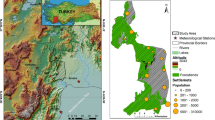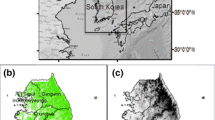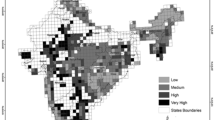Abstract
The conceptual scheme of integrated assessment of vulnerability to climate change in Siberian forests is elaborated and applied to the extensive area in Siberia covered by Larch forests. Forest stakeholders on the provincial level are identified to be the most relevant for an integrated impact assessment. Organisation of the assessment study as a combination of 'top-down' and 'bottom-up' approaches is suggested. Major biophysical vulnerability indexes and regional syndromes are identified as the growing stock and current increment averaged by administrative unit. Models and data suitability and quality for an analysis of biophysical vulnerability in conditions of climate change are studied for Siberian forests and future development trends are identified. An application of the elaborated conceptual scheme, which employs two models of different type and forest inventory data, is presented for the Larch area.
Similar content being viewed by others
References
1995, Forest State Account of Russia for 1993. Moscow, Russian Federal Forest Service.
Arnell, N.W.: 1999, ‘Climate change and global water resources’, Global Environmental Change 9, S31–S49.
Boughton, D.A., Smith, E.R. and O'Neill, R.V.: 1999, ‘Regional vulnerability: A conceptual framework’, Ecological Health 5(4), 312–322.
Bousquet, P., Ciais, P., Peylin, P., Ramonet, M. and Monfray, P.: 1999, ‘Inverse modelling of annual atmospheric CO2 source and sins. 1. Method and control conversions’, Journal of Geophysical Research 104, 26161–26178.
Braun, R.: 1974, ‘Die methodische Entwicklung der Österreichischen Forstinventuren’, in: 100 Jahre Forstliche Bundesversuchanstalt.
Brovkin, V., Claussen, M., Petoukhov, V. and Ganopolski, A.: 1998, ‘On the stability of the atmosphere-vegetation system in the Sahara/Sahel region’, Journal of Geophysical Research 103(D24), 31613–31623.
Cash, D.W. and Moser, S.C.: 2000, ‘Linking global and local scales: Designing dynamic assessment and management processes’, Global Environmental Change 10, 109–120.
Chilingarajan, T.H.: 1959, Finalizing of forest inventory in the USSR. in: Forest Inventory and Planning in the USSR. Moscow, LesProject.
Danjuilis, S.P., Shirin, V.M., Sukhich, V.I. and Elman, P.I.: 1989, Application of Remote Sensing for Forestry, Moscow, Agropromizdat.
Dargaville, R., McGuire, A.D. and Rayner, P.: 2002, ‘Estimates of large-scale fluxes in high latitudes from terrestrial biosphere models and an inversion CO2 measurements’, Climate Change 55, 273–285.
Downing, T.E., Buttefield, R., Cohen, S., Huq, S., Moss, R., Rahman, A., Sokana, Y. and Stephen. L.: 2001, Climate Change Vulnerability: Linking Impacts and Adaptation. Nairobi, Oxford, UNEP and Environmental Change Institute, University of Oxford.
Easterling, W.E.: 1997, ‘Why regional studies are needed in the development of full-scale integrated assessment modelling of global change processes’, Global Environmental Change 7(4), 337–356.
Esser, G.: 1992, Osnabrück Biosphere Model – Structure, Construction, Results. in: Modern Ecology. G. Esser and D. Overdieck. Sara Burgerhartstraat 25/PO Box 211/1000 AE Amsterdam/Netherlands, Elsevier Science Publ B V: 679–709.
Evert, F.: 1975, Inventory-oriented stand development tables for northern Ontario pulpwood cover types. Ottawa, Ontario, Department of Environment, Canadian Forest Service.
Evert, F.: 1976, Management-oriented yield tables for jack pine cover type in northern Ontario. Ottawa, Ontario, Department of Environment, Canadian Forest Service.
Faernside, P.M., Lashof, D.A. and Moura-Costa, P.: 2000, ‘Accounting for time in mitigation global warming trough land-use change and forestry’, Mitigation and Adaptation Strategies for Climate Change 5, 239–270.
Falaleev, E.N., Bezzabotnov, E.L., Danilin, M.A., Semechkin, I.V. and Sokolov, E.K.: 1975, Growth of Main Forest Species in Siberia, Krasnoayarsk, Siberian Technological Institute.
Foley, J.A., Prentice, I.C., Ramankutty, N., Levis, S., Pollard, D., Sitch, S. and Haxeltine, A.: 1996, ‘An integrated biosphere model of land surface processes, terrestrial carbon balance, and vegetation dynamics’, Global Biogeochemical Cycles 10(4), 603–628.
Gignoux, J., Menaut, J.C. Noble, I.R. and Davies, I.D.: 1998, A spatial model of savanna function and dynamics: Model description and preliminary results. in: Dynamics of Tropical Communities. D.M. Newbery, H.H.T. Prins and N.D. Brown. Cambridge, Blackwell Scientific Publications: 361–383.
Gosleschoz: 1982, Instruction for Inventory of State Forest Funds, Moscow, USSR State Committee on Forest Mangement.
Haxeltine, A. and Prentice I.C.: 1996, ‘BIOME3: An equilibrium terrestrial biosphere model based on ecophysiological constraints, resource availability, and competition among plant functional types’, Global Biogeochemical Cycles 10(4), 693–709.
Hulme, M., Mitchell, J.K., Ingram, W., lowe, J. Johns, T., New, M. and Viner, D.: 1999, ‘Climate change scenarios for global impacts studies’, Global Environmental Change 9, S1–S19.
Isaev, A.S., Korovin, G.N., Bartalev, S.A., Ershov, D.V., Janetos, A., Kasishke, E.S., Shugart, H.H., French, N.H.F., Orlick, B.E. and Murphy, T.L.: 2002, ‘Using remote sensing to assess Russian forest fire carbon emissions’, Climate Change 55, 235–249.
Kiviste, A.K.: 1988, Forest Growth Functions. Tartu, Estonian Academy of Agriculture Korjakin, V.N.: 1990, Forest Inventory Reference Book for the Far East. Khabarovsk, Far Eastern Forestry Institute.
Kudelia, V.A.: 1988, Larch Stands of Central Jakutia. Krasnoiarsk, Siberian Branch of the USSR Academy of Sciences.
Lorenzoni, I., Jordan, A., Hulme, M., Turner K.R. and O'Riordan, T.M.: 2000, ‘A coevolutionary approach to climate change impact assessemnet: Part1. Integrating socio-economic and climate change scenario’, Global Environmental Change 10, 57–68.
Lucht, W., Prentice, I.C., Myneni, R.B., Sitch, S., Friedlingstein, P., Cramer, W., Bousquet, P., Buermann, W. and Smith, B.: 2002, ‘Climatic control of the high-latitude vegetation greening trend and pinatubo effect’ Science 296(5573), 1687–1689.
Marschall, J.: 1975, Hilfstafeln für die Forsteinrichtung. Wien, Österreichische Agrarverlag.
Martin, P.: 1989, Description of a land-surface scheme for use in vegetation models. Laxenburg. International Institute of Applied Systems Analysis, WP-9.
Mitchell, J.K.: 1989, Hazards research. in: Geography in America. G.L. Caile and C.J. Willmot. Merrill, Columbus: 410–424.
Nikitin, K.E. and Schvidenko, A.Z.: 1976, Methods for Processing of Forest Inventory Data. Moscow, Lesnaja promyshlennost'.
Nungesser, M.K., Joyce, L.A. and McGuire, A.D.: 1999, ‘Effects of spatial aggregation on predictions of forest climate change response’, Climate research 11, 109–124.
Orlov, M.M.: 1927–1928, Forest Inventory and Forest Management. Leningrad, Lesnaja promyshlennost'.
Parry, M.L., Carter, T.R. and Hulme, M.: 1996, ‘What is a dangerous climate change’, Global Environmental Change 6(1), 1–6.
Pavlov, A.V.: 1996, ‘Permafrost-climatic monitoring of Russia: Analysis of field data and forecasts’, Polar Geography and Geology 20, 44–64.
Pavlov, V.N. and Demidov, E.S.: 1971, ‘Accuracy of forest inventory and factors of this accuracy’, Lesnoe Choziaistvo 8, 47–49.
Payandeh, B. and Wang, Y.: 1996, ‘Variable stocking yield functions for the boreal mixewood in Ontario’, The Forestry Chronicle 72(4), 416–419.
Prentice, I.C., Sykes, M.T. and Cramer, W.: 1991, ‘The possible dynamic response of northern forests to greenhouse warming’, Global Ecology and Biogeography Letters 1, 129–135.
Sagreev, V.V., Sukhikh, V.I., Shvidenko, A.Z., Gusev, N.N. and Moshkalev, A.G.: 1992, All-Union Standards and Normes for the Forest Inventory, Moscow, Moscow.
Shvidenko, A. and Nilsson, S.: 1994, ‘What do we know about the Siberian forests?’ Ambio 23(7), 396–407.
Shvidenko, A. and Nilsson, S.: 1997, ‘Are the Russian forests disappearing?’ Unasylva 48(1), 57–63.
Shvidenko, A., Venevsky, S. and Nilsson, S.: 1996, ‘Impact of disturbance on gross and net increment of Siberian forests”. IUFRO Conference on effects of environmental factors on tree and stand growth, Berrgiesshübel near Dresden, 219–226.
Shvidenko, A., Venevsky, S., Raile, G. and Nilsson, S.: 1995, ‘A system for evaluation of growth and mortality in Russian forests’, Water, Soil and Air Pollution 82, 333–348.
Shvidenko, A.S., Savich Ju., N., Strochinskij, A.A. and Kashpor, S.N.e.: 1987, Forest Inventory reference Book for Ukraine and Moldavia. Kiev, Uroshaj.
Shvidenko, A.Z. and Yudizkii Y.A.: 1983, Design of Non-Linear Parametric Models. Kiev, Ukrainian Agricultural Academy.
Sitch, S., Prentice, I.C., Smith, B., Arneth, A., Bondeau, A., Cramer, W., Kaplan, J.O., Levis, S., Lucht, W., Sykes, M.T., Thonicke, K. and Venevsky, S.: 2003, ‘Evaluation of ecosystem dynamics, plant geography and ter-restrial carbon cycling in the LPJ Dynamic Global Vegeta-tion Model’, Global Change Biology 9, 161–185.
Smith, B.W., Faulkner, J.L. and Powell, S.D.: 1994, Forest Statistics of the United States, 1992. St. Paul, Minnesota, USA, North Central Forest Experiment Station, US Forest Service.
Smith, J.B., Schelnhuber, H.-J. and Mirza, M.Q.: 2001, Vulnerability to Climate Change and Reasons for Concern. in: Climate Change 2001: Impacts, Adaptation, and Vulnerability, Contribution of Working Group II to the Third Assessment Report of the IPCC. J.J. McCarthy, O.F. Canziani, N.A. Laery, D.J. Dokken and K.S. White. Cambridge, Cambridge University Press: 913–967.
Smith, T.M., Shugart, H.H. and Woodward, F.I. Eds.: 1997, Plant Functional Types, International Geosphere-Biosphere Programme Book Series. Cambridge, Cambridge University Press.
Stinson, G. and Freedman, B.: 2001, ‘Potential for carbon seqeustration in Canadian forests and agroecosystems’, Mitigation and Adaptation Strategies for Climate Change 6, 1–23.
Tchebakova, N.M., Monserud, R.A., Leemans, R. and Nazimova, D.I.: 1995, Possible vegetation shifts in Siberia under climatic change. in: Impacts of Climate Change on Ecosystems and Species: Terrestrial Ecosystems. J. Pernetta, R. Leemans, D. Elder and S. Humphrey. Gland, Switzerland, International Union for Conservation of Nature and Natural Resources, IUCN: 67–82.
Thonicke, K., Venevsky, S., Sitch, S. and Cramer, W.: 2001, ‘The role of fire disturbance for global vegetation dynamics: Coupling fire into a Dynamic Global Vegetation Model’ Global Change Biology 10, 661–667.
Tzai, S.I., Piskun, A.T. and Kuz'menkov, M.V.: 1981, Pine and Larch Stands of Buriatia. Inventory Results. Ulan-Ude, Buraitskoe khizhnoe izdatel'stvo.
UNDRO :1982, Natural Disasters and Vulnerability Analysis. Geneva, United Nations Disaster Relief Organ.
Venevsky, S.: 2001, Broad-scale vegetation dynamics in north-eastern Eurasia – observations and simulations. Vienna, Universität für Bodenkultur: 1–150.
Venevsky, S.: 2005, ‘Active layer thickness and permafrost hydrology: Implementation in a global vegetation model’, Permafrost and Periglacial Processes (submitted).
Venevsky, S., Thonicke, K., Sitch, S. and Cramer, W.: 2002, ‘Fire in human-dominated ecosystems: Example of Iberian Peninsula’, Global Change Biology 8, 984–998.
Venevsky, S.V. and Shvidenko, A.Z.: 1996, ‘Modelling of stand growth dynamics with a destructive stage’, VII Conference of the IBFRA, St. Petersburg, VNIIZlesresurs,. 56–57.
White, A., Canell, M.G.R. and Friend, A.D.: 1999, ‘Climate change impacts on ecosystems and the terrestrial carbon sink: A new assessment’, Global Environmental Change 9, S21–S30.
Author information
Authors and Affiliations
Corresponding author
Rights and permissions
About this article
Cite this article
Venevsky, S. A Method for Integrated Assessment of Vulnerability to Climate Change in Siberian Forests: Example of Larch Area. Mitig Adapt Strat Glob Change 11, 241–268 (2006). https://doi.org/10.1007/s11027-006-1024-4
Received:
Accepted:
Published:
Issue Date:
DOI: https://doi.org/10.1007/s11027-006-1024-4




